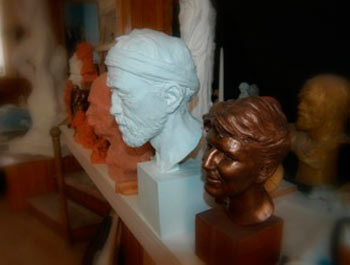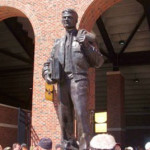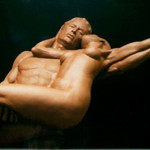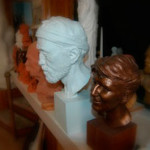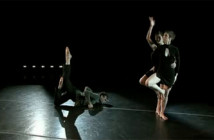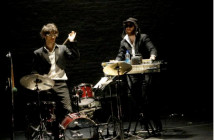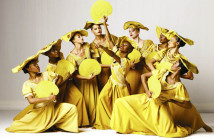MODERN DAY SAINT-GAUDENS: LAWRENCE J. NOWLAN
“A Sculptor’s work endures so long that it is next to a crime for him to neglect to do everything that lies in his power to execute a result that will not be a disgrace.”
- Augustus Saint-Gaudens
Past the pickup trucks parked outside Dan’s Diner and the No Name Coffee and Tea café, and on the same side of Windsor, Vermont’s Main Street as the veterans memorial he created for the town in 2002, sculptor Lawrence J. Nowlan crafts his monuments and his intricate reliefs in a converted, white clapboard church. The peeling front door at Number 53 sticks aggressively, before finally yielding to a visitor’s efforts. Inside, an expectation of pews is supplanted by a bare wooden floor coated with fine clay particles. Clay busts and twisted statues stare down from where they guard the former altar as if ready to deliver a sermon to an invisible congregation. Afternoon sunlight pierces the stained glass windows, creating rainbows on the uneven floor, illuminating the drifting dust.
In a building where Unitarian men and women once came to mold their souls, Nowlan molds monuments. The setting is appropriate. As an artist, he has learned that you need to have faith: that the next commission is going to come through, that art can pay the bills and that being an artist is what he is meant to be.
Tipping back and forth in a creaking, wooden swivel chair with long rips in the seat, the 43 year-old Nowlan runs one hand over his grey stubble and pauses mid-rock to tell a story, which might be titled, Faith Rewarded. Nowlan’s beginning years as an artist in Vermont were in the late 1990’s and early 2000’s. He was newly married and anxious about writing a large check to a foundry before they finished working on one of his pieces. He called a fellow sculptor who advised him that if he believed in what he was doing he would have to invest himself fully – emotionally and financially. Nowlan took the leap. He wrote the check. When he returned to his studio there was a message on his machine: He had received a commission for a monumental sculpture for the University of Iowa.
“You have to trust what you’re doing is what you’re supposed to be doing,” Nowlan says.
Before he arrived at the place of confidence in his art, before he moved to Vermont to live full time, before his first commission and before he had created pieces for MTV, ESPN, the United States government and the city of Dublin, Ireland, Nowlan was a graduate school student from Manhattan, who had never done a relief sculpture. His tenure in New England began with his first summer as a sculptor in residence at the Saint-Gaudens National Historic Site in Cornish, New Hampshire. Nowlan’s experience of living and working at the same artists’ colony where the revered sculptor Augustus Saint-Gaudens worked at the turn of the 20th century continues to infuse and inform the work he is creating in the 21st century.
Augustus Saint-Gaudens first came to Cornish, New Hampshire in 1885 at the encouragement of his friend and attorney, Charles C. Beamen. After 1900, it became his year-round home and he gave up his studio in New York City, where he had lived for most of his life. Saint-Gaudens lived in Cornish until his death 101 years ago in 1907, but before he succumbed to cancer he enjoyed a long and lauded career.
“He was, like, the premier sculptor of his time,” said the Chief of Interpretation at the Saint-Gaudens National Historic Site, Gregory Schwarz.
As a member of the National Park Service, Schwarz helps maintain and run the Saint-Gaudens Historic Site year-round. In his office, which was really a library with a large desk in the corner, Schwarz smiled as he spoke about Saint-Gaudens’s contribution as an American artist.
“We consider his masterpiece to be the Shaw Memorial. He would consider it to be the Sherman Memorial.” Schwarz said, his perfectly ironed uniform buttoned right to his chin and to the end of his crisp, tan cuffs.
The Shaw Memorial depicts Civil War hero Robert Gould Shaw, the white leader of the first all African-American regiment raised in the North, the 54th Regiment. In the 11 feet by 14 feet high-relief sculpture, Shaw sits stern-faced with his sword ready to raise towards an enemy that only he can see from the height of his horse. His trusting troops cluster in the immediate foreground: no two faces are alike and the closeness of their bodies suggest not only their loyalty to each other, but their allegiance to Shaw as well. Above Shaw and his men an angel flies who could not protect them from fate. Shaw and most of his men were killed at Fort Wagner in South Carolina on July 18, 1863. The best-known version of the Shaw Memorial is Saint-Gaudens’s second version, which was unveiled at the northern corner of Boston Common, just across Beacon Street from the Massachusetts State House, on May 21, 1897. He had worked on the Memorial for roughly thirteen years.
For the later sculptures Saint-Gaudens created while at Cornish, he relied heavily on talented assistants, both male and female. While he cultivated many young sculptors, he also encouraged other artists, such as the painter Maxfield Parrish, the architect Charles Platt and the dramatist Percy MacKaye, who came to Cornish for inspiration and space to do their work.
“One of his legacies is that he really continued to be a teacher as well,” said Schwarz.
Today Saint-Gaudens’s role as a mentor to aspiring artists continues through the Saint-Gaudens Historic Site’s summer exhibitions, concert series and workshops, and through the sculptor in residence program.
The sculptors in residence, Schwarz said, waving his hands before clasping them on top of his desk, as if trying to physically contain his enthusiasm, are “a really important part of the interpretative process of sculpting, because people don’t really understand how the stuff is created.”
A sculptor in residence is an artist who is given a summer studio in which to work. In exchange, the sculptor answers visitors’ questions, keeps an open studio door so people can see a work in progress, and leads workshops on sculpture creation from the basics to the bronze casting. Lawrence Nowlan participated for the first of five summers in 1995.
Schwarz affectionately refers to Nowlan as “Doobie,” a childhood nickname that stuck, or Larry. “We knew he was a great artist so we made him work in an overheated studio and for no pay and talk to tourists, said Schwartz with a full smile, crinkling his scintillating eyes at the corners and bobbing his full head of gray hair.
When Nowlan accepted the offer to come to Cornish he did not know what to expect. Raised in Philadelphia, Nowlan was a graduate student at the New York Academy of Art studying sculpture at the School of Figurative Art and he had just had a late night at his studio when Schwarz woke him up for an early morning phone interview. Discombobulated, groggy with lack of sleep, and eager to get off the phone as soon as possible, Nowlan convinced Schwarz to let him drive up to New Hampshire for a face-to-face chat rather than conduct it at that moment over the phone.
In person, the only signs that betray that Nowlan is no longer an artist fresh out of school are the soft lines at the edges of his eyes and the grey in the stubble across his chin. He is quick to move his slight frame from corner to corner of his large studio, but when he moves he manages to infuse an artistic amble with purpose, as if the movement was part of the process of working out his thoughts. His hands suggest he is either an artist or a construction worker: the fingers worn rough, the nails short with bits of clay caught underneath.
In his Windsor, Vermont studio, Nowlan, wearing a flannel shirt tucked into jeans and red boots with worn leather laces and a coating of grey clay on the toes, smiles at the memory of his first few days in Cornish.
He recalls wandering around the Saint-Gaudens Site for a couple of days, doing nothing but observing the art and the views of Mt. Ascutney. Then he found a bag of forgotten clay and pushed and prodded it until he had created his first relief sculpture.
Nowlan leans forward, elbows on knees, and explains how a scene from the movie Good Will Hunting summed up that moment – the scene where Matt Damon, as Will Hunting, is trying to account for his gift for math by comparing it to the way Beethoven saw a piano. Damon says, “Beethoven, okay? He looked at a piano, and it just made sense to him. He could just play.”
When Nowlan looks at clay he can just play.
He received his first major commission while working at the Saint-Gaudens Historic Site: three monumental sculptures for the National Wildland Firefighters Monument in Boise, Idaho. Nowlan’s eight-feet-tall creations call to mind the haunting figures of the Korean War Memorial in Washington, D.C., which were made by another Vermont sculptor, Frank Gaylord. The three figures each hold a different tool of a “fire-line.” One clutches a chainsaw, another a shovel, and the third a tool known as a Pulaski. The seriousness of their expressions echoes the unseeing gazes of the soldiers in the Shaw Memorial: they are thinking of the battle to be fought, not looking at the viewer. The wrinkles in their uniforms suggest movement even as the viewer is able to sense the weight of the figures, as if they were connected by roots to the land their presence consecrates.
The enormity of the Firefighter Monument project prompted Nowlan to rent studio space in Windsor at the end of the summer of 1996 instead of returning to New York City so he could continue his work without a pause.
“In hindsight, I had no idea what I was doing,” Nowlan said about making Vermont his home state. He met his wife Heather, who was a ranger at the Saint-Gaudens Site, moved into his current studio, got married, had a daughter – named Monet – and then before he knew it he was settled, a New England-based artist.
“I love it up here,” Nowlan said before admitting that it “might have been a lack of making a choice that kept me here.”
Most days Nowlan is at work around 7:00 a.m. and leaves between 5:00 and 6:00 p.m. He used to work seven days a week, but now that he’s married with a toddler he tries to spend more time at home. Monet, who will turn two in May, and Heather stop by the studio as well. Just before I arrived, Monet had requested her dad turn off the U2 and Bob Dylan he had been playing and put on a CD of Tchaikovsky so she could dance around the spacious church-cum-studio, flitting between easels and barrels of clay.
At the beginning of his career Nowlan use to worry about the next project, the next commission, before he realized that was taking his energy away from the art he was actively creating. Now he only worries a little, but about critics. “As a sculptor you are wide open,” Nowlan said. “Being that vulnerable takes some getting use to.”
But vulnerability, Nowlan emphasized, has also made him more sensitive in his work. “There are some people who are spectacular technicians – emotionally, I think, is [how]I do the job.”
In October 2007, Nowlan traveled to Ireland for the unveiling ceremony of two of his low reliefs. The relief to be placed in Dublin was a profile of Saint-Gaudens, a commemorative plaque created for the great artist’s birthplace by a modern artist who considers him an inspiration and a mentor.
With the Motown CD Nowlan had put in at my request nearing the final track, I approach the door to leave. Nowlan stops me. He has something to give me, he says, his equivalent of a business card. Stooping below a tool table, Nowlan flips through slabs of molded clay as if they were pages in a Rolodex. He finally settles on one, dusts it off with a paintbrush, binds it in tape and bubble wrap, and hands it to me: a low relief placard of Saint-Gaudens with Nowlan’s contact information written below the sculptor’s profile.
As I exit through the church doors into the fresh air of a Vermont afternoon, Nowlan turns back to the relief plaque he had been working on, a profile of a young man commissioned by the man’s parents after his death.
Saint-Gaudens, like Nowlan, was not a man to philosophize about the way a career unfolds, the way life turns out. However, in the last days before his death, he managed to encapsulate on paper an artist’s philosophy in one sentence: “You can do anything you please,” he wrote; “it’s the way it’s done that makes the difference.”
- Sculptures by Lawrence J. Nowlan

